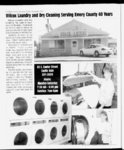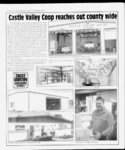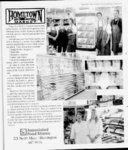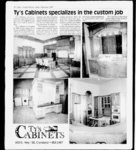| OCR Text |
Show B B "(ilfi 4A Tuesday Sun Advocate September 30, 2003 Staff editorial Responsibility for school costs should fall on users across the country every few years. By RICHARD SM AW In the report it not only compares like Slat! reporter A recent report that American School and University Magazine released on the growth in Amerca of public school districts, points out some very interesting things about the state of Utah's school system. The magazine, which has been published since the 1920's and is probably one of the most respected magazines for school administrators and board members, presents the study of the trends in districts and states school districts and states as to what they are doing in the field of education as far as growth management, budgets, facilities and auxiliary pro- grams. The report shows that the majority of the fastest growing school districts are naturally in states that are growing fast too. These are states like California, Texas and Florida. In fact of the top 100 largest districts, 41 are from those state systems. Most people recognize that the largest districts of all are the same ones that have existed for years. New York City has its own district where over a million students attend school each day. Contrary to popular belief, that district is still growing with nearly 80,000 more students in 2002 than it had in 1992. Los Angeles, the second largest district in the nation, has 735,000 students and the city is looking to pass a bond to build many more schools as it continues to grow as well. A school districts size is often a function of how the geography of the Americans continue to give to others district was set up initially. Probably the fastest grow ing district in the country is the Clark County School District (where the Las Vegas metropolitan area is located). It's grow th has been huge in the past 20 years and this fall alone they had to open 12 new schools to keep up with the number of students in school. It is a county wide district that has a huge geographical area. In contrast, if all four districts in Salt Lake County were organized into one district like Clark County, it's size (Continued on page 7A) By KEN LARSON Sun Advocate publisher In spite of the slow economy Americans are more generous than ever. In a time when the American economy continues to suffer and we are being asked to support an administration that is asking for over $87 billion dollars to rebuild Iraq, Americans are voluntarily parting with more of their own money. This report was issued recently by the Guest editorial Utah schools left behind By JIM MATHESON United States Congressman As w e start another school year, I am troubled by news from across our state about the implementation of the No Child Left Behind Act (NCLB). The concepts and ideas behind this federal education reform legislation remain just as good as they w'ere two years ago when with bipartisan support Congress enacted the bill at the urging of President Bush. Despite the bills good intentions - such as improving student achievement, increasing teacher quality, and providing par-en- ts with greater options legislations implementation RESTRICTION LANDSCAPING DECISIONS POST-WATE- R Letters to the editor There is a few historical precedents of a people so obsessed with themselves that they permit their government to decapitate their culture by removing religion from all but the most private domains. Michael Newdow, with his incoherent claims of constitutional support for his crusade against the Pledge of Allegiance, is only the latest antireligious extremist granted a hearing by the modem American secularist establishment. His ludicrous claims-th"it's my parental right to the keep government off my child" (even as he insists on allowing the government to educate his child in public school), and "the Constitution says that the government isnt supposed to be infusing religion into our society"-don- 't deserve to be dignified by further comment here. But unfortunately, many Americans now believe, at least in part, the outrageous fallacies and distortions One nation under God Editor: Throughout most of human history, progress has been driven primarily by religion, by man's desire to glorify the Almighty. All of the advances in limited government that prepared the way for the founding of America came about as men in the various European nations groped for ways to configure government so as to please God and to agree with the n constraints of natural law. The mightiest works of art and architecture, from the towering Gothic cathedrals of the high Middle Ages to the soaring music of Bach and I landel, were all the products of men seeking to glorify God by fulfilling the highest human impulses. The same could be said of most of the greatest inventors and scientists, at least until fairly recently. at God-give- Letters to the editor should focus on public issues rather than private personalities or entities. All submissions must be verified prior to publication. The paper reserves the right to edit letters not only to satisfy space constraints, but potential liability concerns. about religion and government foisted on them by the media and the public schools, and dutifully retailed by the likes of Newdow. We are tragically, well on our way to becoming a post Christian civilization. America, however, cannot deny God's supremacy and remain free. To drift away from our Christian moorings is to chart a course into bondage, both spiritual and political. The French Revolutionaries and others of their ilk began by erecting secular, even anti Christian states glorifying man, and ended up enslaving themselves under mob rule, guided and harnessed by tyrants and demagogues. For us there can be no middle ground; we either mimic the mistakes of those who turned their backs on their Creator, or keep both ourselves and our government subservient to r, the supreme remaining, as our Founders hoped, one nation under God. James Franklin Rinehart Price Law-give- ii The voice of Carbon County since 1892 ADMINISTRATION Publisher Ken Larson 637-073- Fax ADVERTISING Advertising Bob Hcnline Jenni Fasselin Patti O'Neil Classifieds, Legals Lynda Barnett EDITORIAL Editor Lynnda Johnson Reporter Richard Shaw Reporter Karen Basso OFFICE Office Manager Linda Thayn Receptionist Lynda Barnett Circulation Darla Lee 1IOLRS Monday Friday 8:30 a. lit. to 5 p.111. Address: 845 East Main, Price, Utah. Telephone: (435) : (435) 637-271- Postmaster: Send change of address to 845 East Main Street, Price, Utah 84501. Classifieds deadline: , Monday at 10 a.m. for Tuesday's publication and Wednesday at 10 a.m. for Thursday's publication. Subscription rates: 50 cents per copy, $37 per year in Carbon and Emery counties, $40 in Utah and $54 outside of Utah per year by mail. Conferences can aide in handling problems I recently attended the "Annual Resource Conference" for children with special health care needs, such as Fragile X, and Seizure Disorders. The conference was presented by the Southeastern Utah Health District at CEU and put together by Mae Aguayo. The speaker, Dr. John Carey, noted geneticist from Primary Children's I lospital did an excellent job of helping everyone there understand genetic research, what is happening in the research on genetics, and why it is important to everyone. Dr. John Carey, Geneticist; Dr. Francis Filloux, Neurologist; and Dr. Louis Allen, Developmental Pediatrician took time out from the their busy schedules to be available to answer questions during break-osessions. These breakouts gave us the rare opportunity to interact personally with the specialists, and ask about things particular to our own child's illness. My granddaughter has Rett Syndrome. This disease affects the neurological system causing a communication failure between the nerves and brain., The prognosis is not good, but several things Dr. Carey told us gave new hope. I le told us about Rett research going on at ut Publication No. (USPS 174-96issued twice a week at Price, Utah. Periodical postage paid at Price, Utah, and at additional mailing office PO Box 589, Castle Dale, Utah 84513. Internet: http:www.sunad.com editorto sunad.com, ads(y sunad.com Entire contents copyright 2003 Sun Advocate Inc. All rights reserved. No part of the publication may be reproduced in any form with out the express consent of the Sun Advocate's managing editor or publisher. the has strayed off course. How bad is it? Under the strictest interpretation of standards, 78 out of the 83 schools in the Jordan School District w'ill be designated as failing In rural Utah, it is quesschools. tionable whether any junior high or high school will be able to meet all of the criteria. This doesn't make sense. Ive met with teachers, principals, parents, school board members, and superintendents throughout the state, and I know first hand about the good work that is done every day in our schools. Utah schools face challenges based on large class sizes and low state funding. Now, due to the imposition of a new series of under-funde- d federal requirements, they face the possibility of being labeled failures. There are tw;o basic problems with the implementation of NCLB. First, NCLB promised significant federal funding to assist local schools in In fact, meeting new requirements. a strong commitment to fund the NCLB requirements was critical in garnering overwhelming bipartisan support for the legislation. Unfortunately, when it came time to provide the actual funding. Congress fell short by $9 billion. At a time when state budgets are already tight, federal requirements that push schools to do more with less set up our schools to Fund-raisin- gave away a record $241 billion last year, a one percent increase from the previous year. Leading the way with the generous giving are traditional taxpayers such as individuals and corporations, while falling behind are the nonprofit foundations. Americans are amazing. Look at how our communities are built and run. Most of the events I cover include activities that are run by and sponsored by volunteers. Hundreds of people spend endless hours giving back to the community. As the report points out, people are more apt to support causes in their ow;n community where they see the results. Here are the statistics on giving in this country. Giving by individuals in 2002 is estimated to have increased 0.7 percent, to $183,73 billion. Giving by individuals represents 76.3 percent of all giving estimated for 2002.-- . Giving by corporations in 2002 is estimated to have growm by 10.56 percent to $12.19 billion, from a revised estimate of $11.03 billion for 2001. Giving by corporations is 5.1 percent of all estimated giving in 2002. Giving through bequests in 2002 is estimated to have increased two percent to $18.1 billion. Gifts through bequests represent 7.5 percent of the 2002 total estimated giving. Giving by foundations in 2002 is reported by the Foundation Center to show an esti- mated decrease of 1.2 percent, at $26.9 billion for grant making by independent, community and operating foundations. Grant making by foundations represents .2 percent of all estimate giving in 2002. 1 1 A report by Darrell McKigney, president, of the Small Business Survival Committee, summarizing these numbers asks this question and answ'er. So why is it that so many taxpaying Americans seem to be giving more to charity, but are increasingly opposed to tax increases? One reason might be that they seem to have different priorities for where their, money should be spent. In terms of dollars received, The Giving USA report ranks the 2002 charitable recipients as follows: religion get 35 percent; (Continued on page 7A ) A fail. Editor: liocas - g American Association of Counsel who points out that Americans (Continued on page 5A ) Second, as with any complex law enacted by Congress, the federal agency responsible for administration develops specific regulations. In the case of NCLB, the U.S. Department of Education has developed a set of regulations based on an extreme interpretation of the legislation. There Web Poll A are many problems with the way NCLB regulations have evolved, but lets look at two examples. Acknowledging that quality teaching is critical to student performance, NCLB calls for teachers to meet com- petency and training standards for subjects they teach. This sounds reasonable, but any new Utah secondary teacher is required to have a Bachelors Degree in the subject that he or she teaches. In rural schools, teachers often must teach multiple subjects. In the case of foreign language teachers, many Utah teachers are former LDS missionaries with foreign language fluency. Even if these teachers have college minors in the language, they w'ould not be considered qualified to teach the subject. Special education teachers also teach a variety of subjects every day is it reasonable to require multiple college degrees? Clearly, greater flexibility is necessary in ensuring teacher quality. NCLB recognized that teacher turnover is a problem. It directs states to ensure that poor and minority children are not taught by inexperienced teachers at higher rates than other children. Again, this sounds reasonable, but the implementation has proven problem-(Continue- d on page 7A ) In a meeting before the county com-- ! mission two weeks ago some residents! expressed concern about flood control in their neighborhood (see front page story Sept. 23). Do you think that the county should be in charge of developing flood control plans and controls, or should it only be a part of an overall solution working with private concerns! and individual citizens to achieve a pro-- .' gram? Here are the results as of Mon- -' day afternoon. 76 (28 votes) D County should take lead 24 (9 votes) County just part of solution This question will be on the site for an- other week. We want your opinion. Click on ww'w.sunad.com to be a part of this poll. |










































